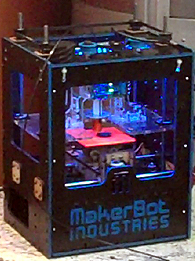 Every movie in the 80’s talked about plastics being the wave of the future. As I sit here in my office surrounded by plastic gizmos and gadgets, typing away on my plastic keyboard, and listening to music crank out my plastic speakers; there is no doubt that those predictions have come true… almost. In truth, we’ve only seen the first phase of the plastic boom – the top down, manufactured approach where companies make and consumers buy. Well strap on your seatbelts folks, because Plasticiety is rapidly approaching and the wave it’s riding is called MakerBot.
Every movie in the 80’s talked about plastics being the wave of the future. As I sit here in my office surrounded by plastic gizmos and gadgets, typing away on my plastic keyboard, and listening to music crank out my plastic speakers; there is no doubt that those predictions have come true… almost. In truth, we’ve only seen the first phase of the plastic boom – the top down, manufactured approach where companies make and consumers buy. Well strap on your seatbelts folks, because Plasticiety is rapidly approaching and the wave it’s riding is called MakerBot.
In the not-so-distant future, we will all have MakerBots on our desktops or in our garages. They will do to manufacturing what desktop publishing did to printing; put it in the hands of the commoner. Makerbots are open source 3D printers. Similar to how a hot glue gun works – plastic tubing goes in one side, gets heated up into a liquid stream and is injected onto a surface (layer by layer) to form a 3-D object. Today the 3D object is limited in size to 4″x4″x6″, but that will increase in the wake of Plasticiety. Products will dawn stickers that define what percentage of MakerBot printable parts comprise them. Consumer purchasing decisions will be partially based off of this volunteer rating because it will mean the products can be easily repaired. Did the knob break off of your stove? No problem, just go to GE.com and download the 3D knob object that matches your part number and print out a new one. Tired of losing or breaking the battery cover for your remote controls? Put down the duct tape and have Makerbot print a new one. Uh oh, the kids lost the toothpaste cap again, surf over to Crest.com, download the object, and print a few spares.
But that describes only the tip of the iceberg! Sharing and community will do to manufacturing what it has done to music… irrevocably flip it on its head. Just visit some of the many object sharing communities that this revolution will foster, download the object models that intrigue you, and then print them into existence. Objects will be simple at first: hooks and hangers, Jello molds, cookie cutters, spatulas, spoons, measuring cups, salt and pepper shakers, coasters, bottle caps, etc. – but they will become more complex as the phenomenon takes off. In addition to the plastic tubing (aka – print cartridges), our local hardware and office supply stores will sell bundles of simple parts like springs, hinges and simple motors. With easily downloadable instructions, you will quickly be able to assemble your homemade parts into more complex creations. Likew ise, when you find or invent items that are useful, it will be easy to post them to the community and share them with your friends.
ise, when you find or invent items that are useful, it will be easy to post them to the community and share them with your friends.
As noted above, today these MakerBots only make items that are smaller than 4″ by 4″ by 6″ and the objects they create have limitations – but that will change as time goes on. The bots you have in your home will become efficient at creating items of larger sizes and at higher qualities. Likewise, 3D object printing shops will begin to show up around town (the Kinkos of Plasticiety) and enable much larger or specialized projects to be completed with the same relative ease and low cost.
You are Here. At the crossroads of hyper-manufacturing and consumer empowerment… where digital turns back into physical and where ideas become tangible objects. Welcome to Plasticiety.
For a glimpse of this future today, check out MakerBot’s website and the open source object marketplace at Thingiverse.com.
